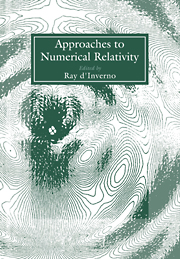Book contents
- Frontmatter
- Contents
- Contributors
- Introduction
- Preface
- PART A THEORETICAL APPROACHES
- PART B PRACTICAL APPROACHES
- Numerical asymptotics
- Instabilities in rapidly rotating polytropes
- Gravitational radiation from coalescing binary neutron stars
- “Critical” behaviour in massless scalar field collapse
- Godunov-type methods applied to general relativistic stellar collapse
- Astrophysical sources of gravitational waves and neutrinos
- Gravitational radiation from 3D gravitational stellar core collapse
- A vacuum fully relativistic 3D numerical code
- Solution of elliptic equations in numerical relativity using multiquadrics
- Self-gravitating thin discs around rotating black holes
- An ADI scheme for a black hole problem
- Time-symmetric ADI and causal reconnection
- The numerical study of topological defects
- Computations of bubble growth during the cosmological quark-hadron transition
- Initial data of axisymmetric gravitational waves with a cosmological constant
- PANEL DISCUSSION
Gravitational radiation from 3D gravitational stellar core collapse
Published online by Cambridge University Press: 15 December 2009
- Frontmatter
- Contents
- Contributors
- Introduction
- Preface
- PART A THEORETICAL APPROACHES
- PART B PRACTICAL APPROACHES
- Numerical asymptotics
- Instabilities in rapidly rotating polytropes
- Gravitational radiation from coalescing binary neutron stars
- “Critical” behaviour in massless scalar field collapse
- Godunov-type methods applied to general relativistic stellar collapse
- Astrophysical sources of gravitational waves and neutrinos
- Gravitational radiation from 3D gravitational stellar core collapse
- A vacuum fully relativistic 3D numerical code
- Solution of elliptic equations in numerical relativity using multiquadrics
- Self-gravitating thin discs around rotating black holes
- An ADI scheme for a black hole problem
- Time-symmetric ADI and causal reconnection
- The numerical study of topological defects
- Computations of bubble growth during the cosmological quark-hadron transition
- Initial data of axisymmetric gravitational waves with a cosmological constant
- PANEL DISCUSSION
Summary
Abstract. Gravitational radiation from the first phase of the gravitational collapse of a stellar core, i.e. the dynamical phase which precedes the formation of a shock and a bounce, is studied by means of a 3-D pseudo-spectral self-gravitating hydro code. It is shown that the efficiency of this process is very low (of the order of a few percent) and insensitive to the equation of state and to whether the initial configuration is axisymmetric, with an initial quadrupole of rotational or tidal origin, or fully asymmetric. An attempt to treat shock waves in asymmetric situations is described and preliminary results obtained from stellar core bounce are presented.
INTRODUCTION
The gravitational collapse of a stellar core is one of the sources of gravitational radiation which is likely to be detected by the next generation of interferometric gravitational wave detectors (e.g. VIRGO and LIGO projects). However, we need an accurate prediction of the gravitational wave form for a wide range of collapse models in order to interpret the results of the gravitational wave observations.
During the last decade, various attempts have been made to predict the efficiency of this process and to predict wave forms. Most of these papers are based on numerical simulations. Some of them take account of the microphysics and some of them were performed in the framework of General Relativity. However, most of these preliminary works assumed axisymmetry (a complete review of this field can be found in Finn (1989)).
- Type
- Chapter
- Information
- Approaches to Numerical Relativity , pp. 247 - 257Publisher: Cambridge University PressPrint publication year: 1992
- 4
- Cited by



